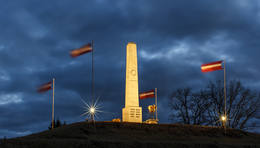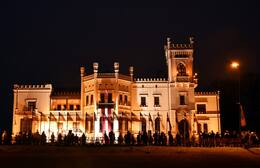7. Siguldos pėstininkų pulko formavimas
1919 m. birželio 20 d. Naukšėnų dvare, Rūjienos apylinkėse, pagal Šiaurės Latvijos brigados vado pulkininko Jorgio Zemitano įsakymą pradėtas formuoti 7-asis Siguldos pėstininkų pulkas. Iš pradžių iš Šiaurės Latvijos brigados rezervinio bataliono buvo suformuota nedidelė kovinė grupė, kurią sudarė 22 karininkai ir 1580 karių, kuri pirmojo vado Oskaro Dankerio garbei buvo pavadinta Dankerio divizija. Po kelių dienų dalinys buvo įtrauktas į 3-iojo Jelgavos pulko 2-ąjį batalioną, o rugpjūčio 23 d., papildžius kuopa, į 7-ąjį Siguldos pėstininkų pulką.
“In Tallinn, I looked for Colonel Zemitāns at his headquarters. In a small narrow street, I found the number I was looking for, according to the address given. A small piece of paper was pinned to the door, on which was written in ink: Headquarters of the Commander-in-Chief of the North Latvian Army. The gray surroundings and simplicity, not to say poverty, oppressed me. But then pride slowly awoke in me along with the thought that it was right to start small, because then you have the opportunity to grow up big and stately. After a short time, I was summoned to Rūjiena. There I met with Colonel Zemitāns’ chief of staff, General Voldemārs Ozolas. He informed me that it was urgent to send Latvian troops to Liepāja, at least in the strength of a regiment. The Commander-in-Chief of the North Latvian Army instructed me to form one infantry regiment from the Rūjiena reserve battalion and appointed me the commander of this regiment. V. Ozols wrote this order in a field notebook, and this little piece of paper was the basis for the formation of the regiment.”
Oskaro Dankerio prisiminimai. Kaip tapau 7-ojo Siguldos pėstininkų pulko įkūrėju ir pirmuoju vadu. „Siguldos pulkui atminti. 1919.20.-VI 1959“. Torontas: Siguldos pulko memorialinis fondas, 1959, 9-10 p.
Alūksnės muziejus
Susijusi laiko juosta
Susijusios temos
Susijusios vietos
Paminklas 7-ojo Siguldos pėstininkų pulko kariams, žuvusiems Latvijos Nepriklausomybės kare
Įsikūręs Alūksnės ežero pakrantėje, Pskevo (Kolbergo) gatvės pusėje.
1923 metų birželio 22 dieną Latvijos prezidentas Jānis Čakste atidengė paminklą žuvusiems 7-ojo Siguldos pėstininkų pulko kariams. Paminklą sukūrė dailininkas Jūlijs Miesnieks.
Pulko kariai taip pat gerino ir tvarkė paminklo aplinką. Kareiviai prie paminklo rinkosi pulko metinių minėjimo išvakarėse, kai uždegdavo šventąją ugnį, taip pat pulko metinių dieną po parado ir užtarimo Garnizono kapinėse.
1940/1941 m. bolševikai pašalino ir sunaikino lentą, tačiau pats paminklas buvo nugriautas 1953 m., o jo akmenys įmūryti į kareivinių pastato kampinius pamatus.
Prasidėjus Atbudimui, 1989 m. rudenį buvo sutvarkyta teritorija aplink sunaikintą paminklą, kuris tuo metu dar buvo SSRS okupacinių kariuomenės teritorijoje. Lapkričio 11 d. buvusioje paminklo vietoje buvo atidengtas laikinas granito memorialas su išgraviruotu tekstu: „7-ojo Siguldos pėstininkų pulko paminklas šioje vietoje bus atkurtas 1989 m. lapkričio 11 d.“
Alūksnės brolių kapinių komiteto vadovo U. Veldre iniciatyva buvo pradėti paminklo restauravimo darbai, o restauruotas paminklas atidengtas 2009 m. spalio 16 d.
Skirtingai nuo originalaus paminklo, ant obelisko vietoj pulko krūtinės šarvų buvo sukurtas kryžius. Abu paminklo reljefus nukalė skulptorius Ainārs Zelčs. Restauruotam paminklui panaudotos tiek 22 originalių obelisko blokų dalys, rastos Nacionalinių ginkluotųjų pajėgų pėstininkų mokyklos teritorijoje, tiek naujai pagaminti blokai.
2019 m. birželio 20 d., minint 7-ojo Siguldos pėstininkų pulko šimtmečio jubiliejų, paminklo kalnelio papėdėje buvo atidengta pulko paminklo atminimo vieta ir granito atminimo lenta žuvusiems dalinio kariams, ant kurios išgraviruotas tekstas: „Jūsų stipri dvasia visada su mumis...“. Atminimo vieta pastatyta Nacionalinių ginkluotųjų pajėgų Pėstininkų mokyklos personalo paaukotomis lėšomis.
Alūksnės muziejus
Alūksnės muziejus įsikūręs nacionalinės reikšmės architektūros paminkle – neogotikinėje Alūksnės Naujojoje pilyje, pastatytoje XIX a. pabaigoje. Muziejuje veikia paroda „Totalitarinio režimo aukų memorialinis kambarys“, kurioje pasakojama apie Alūksnės savivaldybės gyventojų likimus Sibire ir Tolimuosiuose Rytuose, o laikotarpis nuo priešistorės iki šių dienų susitinka Alūksnės istorijos ekspozicijoje „Amžių šventė“. Joje yra atskiras skyrius, skirtas 7-ojo Siguldos pėstininkų pulko indėliui į kariuomenę, kultūrą ir visuomenės gyvenimą. 7-ojo Siguldos pėstininkų pulko formavimas prasidėjo 1919 m. birželio 20 d. Naukšėnų dvare. Iš pradžių iš Šiaurės Latvijos brigados rezervinio bataliono buvo suformuota 22 karininkų ir 1580 kareivių kovinė grupė, pavadinta Dankersų divizija. Ji buvo įtraukta į 3-iojo Jelgavos pulko 2-ąjį batalioną. Rugpjūčio 23 d., padidėjus kuopų skaičiui, jis tapo 7-ojo Siguldos pėstininkų pulko dalimi. Dalyvavęs mūšiuose prieš Bermontą, 1920 m. sausio 5 d. pulkas buvo perkeltas į Latgalos frontą kovoti su bolševikais. Pasirašius taikos sutartį su Sovietų Rusija, pulkas saugojo rytinę Latvijos sieną. Latvijos nepriklausomybės kare žuvo daugiau nei 200 pulko karių, o 85 buvo apdovanoti Lačplėšio karo ordinu. 1921 m. 7-asis Siguldos pėstininkų pulkas buvo dislokuotas Alūksnėje. Pulko štabas buvo įsikūręs Alūksnės naujojoje pilyje. Po Antrojo pasaulinio karo pilį perėmė sovietų saugumo institucijos. Nuo šeštojo dešimtmečio pabaigos pilyje buvo įsikūrusios įvairios kultūros įstaigos: Vykdomojo komiteto Kultūros ir kinematografijos skyrius, pionierių namai, biblioteka, kino teatras ir muziejus.







